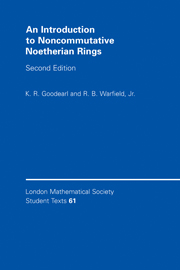Book contents
- Frontmatter
- Contents
- Introduction to the Second Edition
- Introduction to the First Edition
- Prologue
- 1 A Few Noetherian Rings
- 2 Skew Polynomial Rings
- 3 Prime Ideals
- 4 Semisimple Modules, Artinian Modules, and Torsionfree Modules
- 5 Injective Hulls
- 6 Semisimple Rings of Fractions
- 7 Modules over Semiprime Goldie Rings
- 8 Bimodules and Affiliated Prime Ideals
- 9 Fully Bounded Rings
- 10 Rings and Modules of Fractions
- 11 Artinian Quotient Rings
- 12 Links Between Prime Ideals
- 13 The Artin-Rees Property
- 14 Rings Satisfying the Second Layer Condition
- 15 Krull Dimension
- 16 Numbers of Generators of Modules
- 17 Transcendental Division Algebras
- Appendix. Some Test Problems for Noetherian Rings
- Bibliography
- Index
8 - Bimodules and Affiliated Prime Ideals
Published online by Cambridge University Press: 11 November 2010
- Frontmatter
- Contents
- Introduction to the Second Edition
- Introduction to the First Edition
- Prologue
- 1 A Few Noetherian Rings
- 2 Skew Polynomial Rings
- 3 Prime Ideals
- 4 Semisimple Modules, Artinian Modules, and Torsionfree Modules
- 5 Injective Hulls
- 6 Semisimple Rings of Fractions
- 7 Modules over Semiprime Goldie Rings
- 8 Bimodules and Affiliated Prime Ideals
- 9 Fully Bounded Rings
- 10 Rings and Modules of Fractions
- 11 Artinian Quotient Rings
- 12 Links Between Prime Ideals
- 13 The Artin-Rees Property
- 14 Rings Satisfying the Second Layer Condition
- 15 Krull Dimension
- 16 Numbers of Generators of Modules
- 17 Transcendental Division Algebras
- Appendix. Some Test Problems for Noetherian Rings
- Bibliography
- Index
Summary
Bimodules have become of increasing importance in the ideal theory of a noetherian ring R, particularly ideal factors I/J where I ⊇ J are ideals of R, and overrings S ⊇ R, viewed as (S, R)-bimodules. To make the notation more convenient in both cases, we study bimodules in general. In this chapter, we investigate the structure of bimodules over noetherian rings, particularly bimodules which are noetherian or artinian on at least one side, and we illustrate the results by indicating a number of applications, particularly to the relationships between the prime ideals of a ring and the prime ideals of a subring. While the latter sections of the chapter are designed to show the reader several contexts in which bimodules have been successfully used, only the first four sections are strictly needed for later chapters of the book.
• NOETHERIAN BIMODULES •
By a “noetherian bimodule” is usually meant a bimodule RAS which not only has the ACC on sub-bimodules, but also is noetherian as a left R-module and as a right S-module. (Some authors mean in addition that R and S are noetherian rings.) We state our results under somewhat more general hypotheses, while thinking mainly of applications to noetherian bimodules.
Our first result, although elementary, is fundamental to the entire development of noetherian bimodules. In particular, as the exercise following indicates, it gives severe restrictions on which modules can appear as one-sided submodules of noetherian bimodules.
Information
- Type
- Chapter
- Information
- An Introduction to Noncommutative Noetherian Rings , pp. 136 - 155Publisher: Cambridge University PressPrint publication year: 2004
